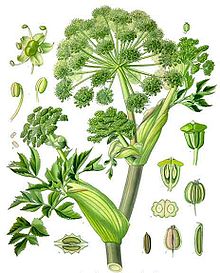Angelica archangelica
| Angelica archangelica | |
|---|---|

| |
| Scientific classification | |
| Kingdom: | Plantae |
| Clade: | Tracheophytes |
| Clade: | Angiosperms |
| Clade: | Eudicots |
| Clade: | Asterids |
| Order: | Apiales |
| Family: | Apiaceae |
| Genus: | Angelica |
| Species: | A. archangelica
|
| Binomial name | |
| Angelica archangelica | |
| Synonyms[2] | |
|
Synonyms list
| |
Angelica archangelica,commonly known asangelica,[3]garden angelica,wild celery,andNorwegian angelica,is abiennial plantfrom the familyApiaceae,a subspecies of which is cultivated for its sweetly scentededible stemsandroots.Like several other species in Apiaceae, its appearance is similar to several poisonous species (Conium,Heracleum,and others), and should not be consumed unless it has been identified with absolute certainty. Synonyms includeArchangelica officinalisHoffm.andAngelica officinalisMoench.[4]
Description and distribution
[edit]
During its first year, it grows only leaves, but during its second year, its fluted stem can reach a height of 2.5 meters (just over 8 feet), and the root is used in flavoring preparations. Its leaves consist of numerous small leaflets divided into three principal groups, each of which is again subdivided into three lesser groups. The edges of the leaflets are finely toothed or serrated. The flowers, which blossom in July, are small and numerous, yellowish or greenish, are grouped into large, globular umbels that bear pale yellow, oblong fruits.Angelicagrows only in damp soil, preferably near rivers or deposits of water.
Angelica archangelicagrows wild inRussia,Finland,Sweden,Norway,Denmark,Greenland,theFaroe Islands,andIceland,mostly in the northern parts of the countries. It is cultivated inFrance,mainly in theMarais Poitevin,a marsh region close toNiortin the departmentDeux-Sèvres.Commercially available angelica is often sourced fromHungary,Romania,Bulgaria,GermanyandPoland.[5]

Use and history
[edit]From the 10th century on, angelica was cultivated as avegetableandmedicinal plant,[6]and became popular inScandinaviain the 12th century and is used especially inSámi culture.It was once used as an herb in Sámi cooking, and known askvanne.[7]
It is used to flavorliqueursoraquavits,(e.g.,Chartreuse,Bénédictine,Vermouth,andDubonnet),omelettesandtrout,and asjam.The long bright-green stems are alsocandiedand used as food decoration. Angelica is unique among theUmbelliferaefor its pervading aromatic odor, a pleasant perfume entirely different fromfennel,parsley,anise,caraway,orchervil.[6]It has been compared tomuskand tojuniper.Angelica archangelicaroots are among the most common botanicals used ingindistillation, often used in concert with juniper berries andcorianderas a chief aromatic characteristic for gin.[8]They are also used inabsinthes,aquavits,andbitters.[9]The hollow stems ofAngelica archangelicamay be eaten. The stems are picked clean of their leaves, crystallized in sugar syrup and colored green as cake decoration or as candy.[10]
Chemical composition
[edit]The essential oil content of angelica root varies based on the age of the roots. Generally, the roots have high levels ofterpenes,includingα-pineneandβ-phellandrene.[11]Studies have found upwards of over eighty different aroma compounds present in samples. Of particular interest to perfumers and aroma chemists iscyclopentadecanolide,which although present in small quantities (< 1% in roots, <.5% in seeds), gives angelica root a distinctive musky aroma.[9][12]The roots are generally preferred for culinary and aroma uses.[9]
Angelica seeds have a similar chemical composition to the roots, including α-pinene,β-pinene,camphene,myrcene,β-phellandrene,limonene,caryophyllene,borneol,carvoneand others.[11]
Both the seeds and roots containcoumarinsand furocoumarins. Among these are 2′-angeloyl-3′-isovaleryl vaginate, archangelicin, oxypeucedanin hydrate,bergapten,byakangelicin angelate,imperatorin,isoimperatorin,isopimpinellin,8-[2-(3-methylbutroxy)-3-hydroxy-3-methylbutoxy]psoralen, osthol, ostruthol, oxypeucedanin, phellopterin,psoralenandxanthotoxin,can be isolated from a chloroform extract of the roots ofA. archangelica[13]as well as several heraclenol derivatives.[14]The water root extract ofA. archangelica subsp. litoraliscontains adenosine,coniferin,the two dihydrofurocoumarin glycosidesapterinand 1′-O-β-d-glycopyranosyl-(S)-marmesin (marmesinin), 1′-O-β-d-glucopyranosyl-(2S, 3R)-3-hydroxymarmesin and 2′-β-d-glucopyranosyloxymarmesin.[15]
Etymology
[edit]Angelicais the Latin feminine name implying "angel-like" from the mid-16th century,probably named for the plant due to its scent.[16]Archangelicaderives from "an angel of the highest order," an Old French term in the late (12th century), or from the Greek word "arkhangelos" ( "chief angel" ).[16]
See also
[edit]- Heracleum persicum(golpar)
- Angelicin
References
[edit]- ^"Angelica archangelica".Germplasm Resources Information Network.Agricultural Research Service,United States Department of Agriculture.Retrieved2008-03-03.
- ^"Angelica archangelicaL. "Plants of the World Online.Board of Trustees of the Royal Botanic Gardens, Kew. 2017.Retrieved11 July2020.
- ^"Angelica archangelica".RHS.Retrieved2 September2023.
- ^"Angelica archangelica L. | Plants of the World Online | Kew Science".Plants of the World Online.Retrieved2018-07-30.
- ^Chauhan, Dr Meenakshi (2019-08-06)."What are the Medicinal Properties of Wild Celery ( Angelica Archangelica)?".Planet Ayurveda.Retrieved2022-04-28.
- ^abM. Grieve."Angelica".A Modern Herbal. Botanical.com.
- ^Nilsson, Lena Maria; Dahlgren, Lars; Johansson, Ingegerd; et al. (18 February 2011)."Diet and lifestyle of the Sámi of southern Lapland in the 1930s–1950s and today".International Journal of Circumpolar Health.70(3): 301–318.doi:10.3402/ijch.v70i3.17831.hdl:10037/4081.ISSN2242-3982.PMID21631968.
- ^Gualtiero Simonetti (1990). Stanley Schuler (ed.).Simon & Schuster's Guide to Herbs and Spices.Simon & Schuster, Inc.ISBN978-0-671-73489-3.
- ^abcJelen, Henryk (2011-10-25).Food Flavors: Chemical, Sensory and Technological Properties.CRC Press.ISBN9781439814918.
- ^Reineccius, Gary (1995). Reineccius, Gary (ed.).Source Book of Flavors - Springer.doi:10.1007/978-1-4615-7889-5.ISBN978-1-4615-7891-8.
- ^abBurdock, George A. (2016-04-19).Fenaroli's Handbook of Flavor Ingredients, Sixth Edition.CRC Press.ISBN9781420090864.
- ^Burdock, George A. (1997).Encyclopedia of Food and Color Additives.CRC Press.ISBN9780849394140.
- ^Härmälä P, Vuorela H, Hiltunen R, et al. (1992). "Strategy for the isolation and identification of coumarins with calcium antagonistic properties from the roots of Angelica archangelica".Phytochemical Analysis.3(1): 42–48.doi:10.1002/pca.2800030108.
- ^Sun H, Jakupovic J (1986). "Further heraclenol derivatives from Angelica archangelica".Pharmazie.41(12): 888-889INIST7473899.
- ^Lemmich, John; Havelund, Svend; Thastrup, Ole (1983). "Dihydrofurocoumarin glucosides from Angelica archangelica and Angelica silvestris".Phytochemistry.22(2): 553–555.doi:10.1016/0031-9422(83)83044-1.ISSN0031-9422.
- ^ab"Archangel".Online Etymology Dictionary. 2021.Retrieved29 July2021.

